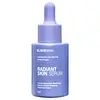What's inside
What's inside
 Key Ingredients
Key Ingredients

 Benefits
Benefits

 Concerns
Concerns

 Ingredients Side-by-side
Ingredients Side-by-side

Water
Skin ConditioningPropylene Glycol
HumectantGlycerin
HumectantNiacinamide
SmoothingPEG-400
Emulsion StabilisingButylene Glycol
HumectantArbutin
AntioxidantCitric Acid
BufferingSodium Sulfite
PreservativeAcetyl Tyrosine
Skin ConditioningSaxifraga Sarmentosa Extract
Skin ConditioningPaeonia Suffruticosa Root Extract
Skin ProtectingAminopropyl Ascorbyl Phosphate
AntioxidantScutellaria Baicalensis Root Extract
AstringentGlutathione
Vitis Vinifera Seed Extract
AntimicrobialLecithin
EmollientLinoleic Acid
CleansingTocopheryl Acetate
AntioxidantSodium Ascorbyl Phosphate
AntioxidantPEG-40 Hydrogenated Castor Oil
EmulsifyingTocopherol
AntioxidantAlcohol
AntimicrobialSodium Hyaluronate
HumectantPhenoxyethanol
PreservativeEthylhexylglycerin
Skin ConditioningAminoethylphosphinic Acid
Skin ConditioningSodium Methylparaben
PreservativeXanthan Gum
EmulsifyingCarbomer
Emulsion StabilisingAminomethyl Propanol
BufferingMethylparaben
PreservativeSodium Metabisulfite
AntioxidantDisodium EDTA
Sodium Bisulfite
AntioxidantWater, Propylene Glycol, Glycerin, Niacinamide, PEG-400, Butylene Glycol, Arbutin, Citric Acid, Sodium Sulfite, Acetyl Tyrosine, Saxifraga Sarmentosa Extract, Paeonia Suffruticosa Root Extract, Aminopropyl Ascorbyl Phosphate, Scutellaria Baicalensis Root Extract, Glutathione, Vitis Vinifera Seed Extract, Lecithin, Linoleic Acid, Tocopheryl Acetate, Sodium Ascorbyl Phosphate, PEG-40 Hydrogenated Castor Oil, Tocopherol, Alcohol, Sodium Hyaluronate, Phenoxyethanol, Ethylhexylglycerin, Aminoethylphosphinic Acid, Sodium Methylparaben, Xanthan Gum, Carbomer, Aminomethyl Propanol, Methylparaben, Sodium Metabisulfite, Disodium EDTA, Sodium Bisulfite
Water
Skin ConditioningCyclopentasiloxane
EmollientAlpha-Arbutin
AntioxidantButylene Glycol
HumectantGlycyrrhiza Glabra Root Extract
BleachingGalactomyces Ferment Filtrate
HumectantCentella Asiatica Extract
CleansingPortulaca Oleracea Extract
Skin ConditioningGlycerin
Humectant3-O-Ethyl Ascorbic Acid
Skin ConditioningAlaria Esculenta Extract
Skin ProtectingDimethylmethoxy Chromanyl Palmitate
Skin ConditioningSodium Hyaluronate
HumectantLactobacillus Ferment Filtrate
Skin ConditioningPhenoxyethanol
PreservativePolyacrylamide
C13-14 Isoparaffin
EmollientLaureth-7
EmulsifyingPEG-40 Hydrogenated Castor Oil
EmulsifyingSodium Benzoate
MaskingDipotassium Glycyrrhizate
HumectantAllantoin
Skin ConditioningDMDM Hydantoin
PreservativeSodium PCA
HumectantParfum
MaskingTetrasodium EDTA
Propanediol
Solvent1,2-Hexanediol
Skin ConditioningIodopropynyl Butylcarbamate
PreservativeAvena Sativa Kernel Extract
AbrasivePotassium Sorbate
PreservativeWater, Cyclopentasiloxane, Alpha-Arbutin, Butylene Glycol, Glycyrrhiza Glabra Root Extract, Galactomyces Ferment Filtrate, Centella Asiatica Extract, Portulaca Oleracea Extract, Glycerin, 3-O-Ethyl Ascorbic Acid, Alaria Esculenta Extract, Dimethylmethoxy Chromanyl Palmitate, Sodium Hyaluronate, Lactobacillus Ferment Filtrate, Phenoxyethanol, Polyacrylamide, C13-14 Isoparaffin, Laureth-7, PEG-40 Hydrogenated Castor Oil, Sodium Benzoate, Dipotassium Glycyrrhizate, Allantoin, DMDM Hydantoin, Sodium PCA, Parfum, Tetrasodium EDTA, Propanediol, 1,2-Hexanediol, Iodopropynyl Butylcarbamate, Avena Sativa Kernel Extract, Potassium Sorbate
Ingredients Explained
These ingredients are found in both products.
Ingredients higher up in an ingredient list are typically present in a larger amount.
Butylene Glycol (or BG) is used within cosmetic products for a few different reasons:
Overall, Butylene Glycol is a safe and well-rounded ingredient that works well with other ingredients.
Though this ingredient works well with most skin types, some people with sensitive skin may experience a reaction such as allergic rashes, closed comedones, or itchiness.
Learn more about Butylene GlycolGlycerin is already naturally found in your skin. It helps moisturize and protect your skin.
A study from 2016 found glycerin to be more effective as a humectant than AHAs and hyaluronic acid.
As a humectant, it helps the skin stay hydrated by pulling moisture to your skin. The low molecular weight of glycerin allows it to pull moisture into the deeper layers of your skin.
Hydrated skin improves your skin barrier; Your skin barrier helps protect against irritants and bacteria.
Glycerin has also been found to have antimicrobial and antiviral properties. Due to these properties, glycerin is often used in wound and burn treatments.
In cosmetics, glycerin is usually derived from plants such as soybean or palm. However, it can also be sourced from animals, such as tallow or animal fat.
This ingredient is organic, colorless, odorless, and non-toxic.
Glycerin is the name for this ingredient in American English. British English uses Glycerol/Glycerine.
Learn more about GlycerinPeg-40 Hydrogenated Castor Oil is derived from castor oil and polyethylene glycol (PEG). It is used as a emollient and emulsifier.
As an emulsifier, it helps prevent ingredients from separating. It also helps make the other ingredients more soluble; it is often used to solubilize fragrances. This increases spreadability and elongates shelf life in a product.
Emollients help soothe and soften the skin. They do this by creating a protective film on your skin. This barrier helps trap moisture and keeps your skin hydrated. Emollients may be effective at treating dry or itchy skin.
This ingredient may or may not be vegan, depending on the source.
Peg-40 Hydrogenated Castor Oil may not be fungal-acne safe. We recommend speaking with a professional if you have any questions or concerns.
Learn more about PEG-40 Hydrogenated Castor OilPhenoxyethanol is a preservative that has germicide, antimicrobial, and aromatic properties. Studies show that phenoxyethanol can prevent microbial growth. By itself, it has a scent that is similar to that of a rose.
It's often used in formulations along with Caprylyl Glycol to preserve the shelf life of products.
Sodium Hyaluronate is hyaluronic acid's salt form. It is commonly derived from the sodium salt of hyaluronic acid.
Like hyaluronic acid, it is great at holding water and acts as a humectant. This makes it a great skin hydrating ingredient.
Sodium Hyaluronate is naturally occurring in our bodies and is mostly found in eye fluid and joints.
These are some other common types of Hyaluronic Acid:
Learn more about Sodium HyaluronateWater. It's the most common cosmetic ingredient of all. You'll usually see it at the top of ingredient lists, meaning that it makes up the largest part of the product.
So why is it so popular? Water most often acts as a solvent - this means that it helps dissolve other ingredients into the formulation.
You'll also recognize water as that liquid we all need to stay alive. If you see this, drink a glass of water. Stay hydrated!
Learn more about Water